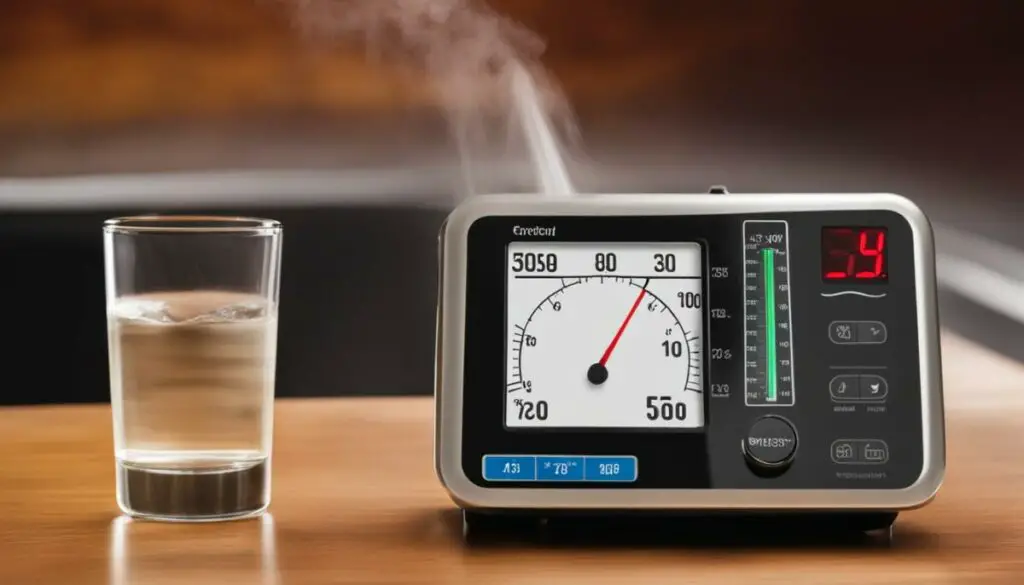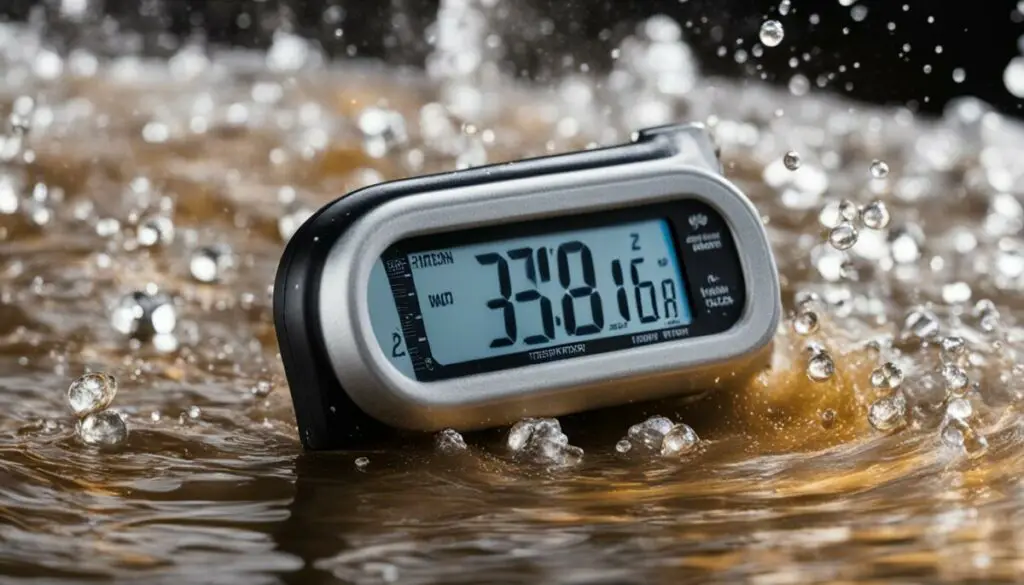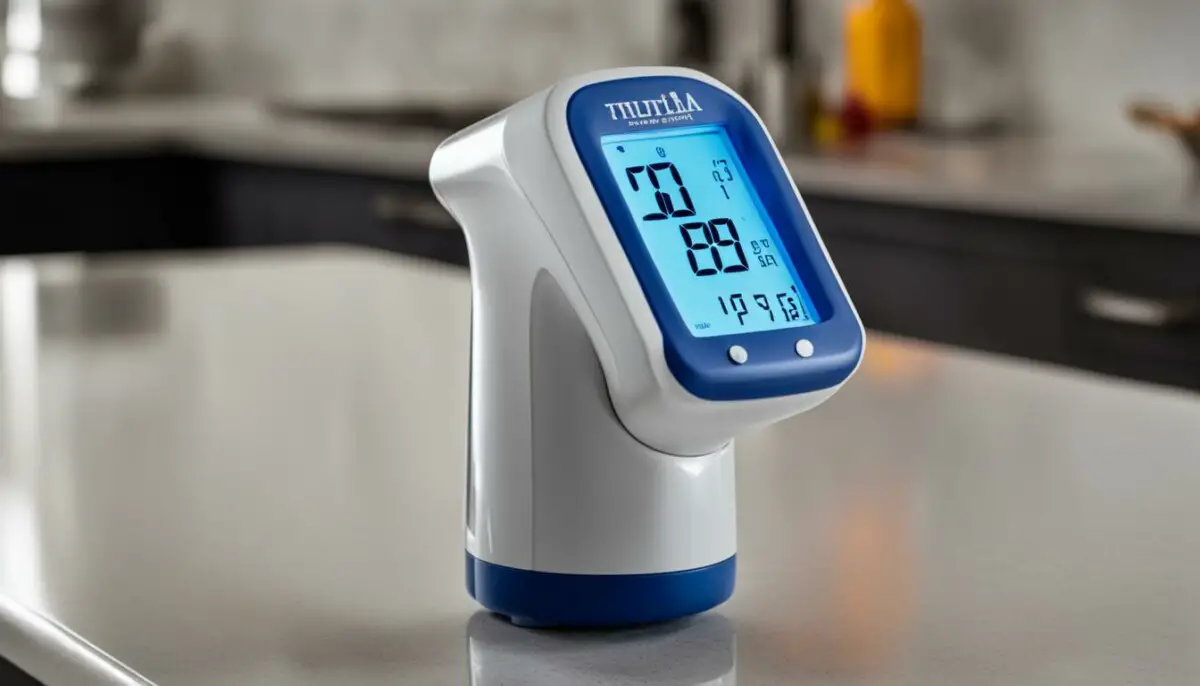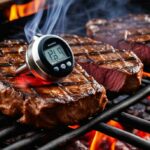Last Updated on 5 months by Francis
If you work in industries that require accurate temperature measurements, you might be curious about whether an infrared thermometer can measure water temperature. In this article, we will explore the capabilities and limitations of using an infrared thermometer to measure the temperature of water.
Before we dive into the specifics of infrared thermometers and their use in measuring water temperature, it’s important to understand how they work. In the next section, we will explain the principles behind infrared thermometers and how they measure temperature without physical contact.
Contents
Key Takeaways:
- Infrared thermometers can measure water temperature, but with limitations
- Understanding the principles of infrared thermometers is important for their use in water temperature measurement
- Choosing the right infrared thermometer for water temperature measurement is critical for accuracy
- Techniques and guidelines can enhance the precision of water temperature measurement with infrared thermometers
- Comparing infrared thermometers with traditional methods can help you make an informed decision about your temperature measuring tools
How Do Infrared Thermometers Work?
Infrared thermometers are designed to measure temperature without physical contact with a surface. They work by detecting and measuring the infrared energy emitted by an object, which is directly proportional to its temperature. In simpler terms, infrared thermometers measure the heat radiated by an object, which can be used to infer its temperature.
When a surface is warmer than its surroundings, it emits infrared radiation that can be detected by an infrared thermometer. The thermometer measures this radiation and calculates the temperature of the surface based on the amount of radiation detected. This technology is often referred to as non-contact temperature measurement, as the thermometer does not need to touch the surface to measure the temperature.
Infrared thermometers are particularly useful for measuring the temperature of objects that are difficult or dangerous to access, such as pipes, ducts, or electrical systems. They can also be used to measure the temperature of moving objects or surfaces that are in motion. For example, they can be used to measure the temperature of a moving conveyor belt on a production line.
When it comes to water temperature measurement, infrared thermometers can be used to measure the temperature of the surface of the water. However, they are not suitable for measuring the temperature of the water itself, as water is transparent to infrared radiation. This means that an infrared thermometer would only measure the temperature of the water’s surface and not the temperature below.
Keywords: infrared thermometer and water temperature, infrared thermometer to measure water temperature
Limitations of Infrared Thermometers for Water Temperature Measurement
While infrared thermometers are a popular choice for temperature measurement, they have limitations when it comes to measuring water temperature. The main challenge is the emissivity of the water surface, which affects the accuracy of the readings.
The emissivity of a surface refers to its ability to emit thermal radiation. Infrared thermometers rely on detecting the radiation emitted from the surface of an object to measure its temperature. However, water has a low emissivity compared to other surfaces, which means that it reflects more radiation than it emits. This makes it challenging to measure the actual temperature of the water accurately.
Another limitation of infrared thermometers for water temperature measurement is the distance to the water surface. The distance between the thermometer and the water surface affects the size of the measurement spot, which can lead to inaccurate readings.
Finally, potential interference from steam or water reflections can also impact the accuracy of the temperature reading. Steam and water reflections can cause the infrared thermometer to read the temperature of the reflection rather than the actual water temperature.
Despite these limitations, infrared thermometers can still be used for measuring water temperature. However, it’s essential to consider these limitations and apply specific techniques to achieve accurate readings.
Using Infrared Thermometers for Measuring Water Temperature
When using infrared thermometers for measuring water temperature, it’s essential to follow specific guidelines to minimize errors and obtain accurate results. Here are some tips:
- Ensure that the infrared thermometer’s emissivity setting is adjusted to account for the low emissivity of water.
- Hold the thermometer as close to the water surface as possible to minimize the measurement spot size and increase accuracy.
- Wait for the steam to clear before taking a measurement. Steam can interfere with the temperature reading.
- Use a black marker or a small piece of black electrical tape to increase the emissivity of the water surface, which improves the accuracy of the reading.
By following these guidelines, you can achieve accurate temperature measurements using an infrared thermometer when measuring water temperature.
Factors Affecting Accuracy of Water Temperature Measurement with Infrared Thermometers

While infrared thermometers are widely used in temperature measurement, measuring water temperature using these devices can be challenging. Inaccurate readings can occur due to several factors:
| Factor | Description | Impact on Accuracy |
|---|---|---|
| Emissivity of the Water Surface | Water has a low emissivity, meaning it does not emit much thermal radiation. This can affect the accuracy of infrared thermometers. | Can result in readings that are too low or too high, depending on the infrared thermometer’s calibration. |
| Distance to the Water | The distance between the infrared thermometer and the water surface can impact the accuracy of readings. | Measurements taken at different distances can result in varying temperature readings. |
| Interference from Steam or Water Reflections | Steam and water reflections can interfere with the accuracy of infrared thermometers. | Can cause readings to be too low or too high. |
Therefore, when using infrared thermometers for water temperature measurement, it’s essential to consider these factors. Understanding the behavior of infrared thermometers and the principles behind how they work can help minimize errors and improve accuracy.
To obtain accurate readings, it’s essential to aim the infrared thermometer at a perpendicular angle to the water surface. Also, avoid measuring near the water edges since the emissivity of water is higher in those regions. Instead, measure the temperature of the central water body to obtain more accurate results.
By keeping these factors in mind, you can accurately measure water temperature using an infrared thermometer and achieve precise and reliable results for various applications.
Techniques for Accurate Water Temperature Measurement with Infrared Thermometers

Measuring water temperature with an infrared thermometer requires proper technique to obtain accurate results. Here are some tips to ensure precise readings:
- Consider the emissivity of the water surface: Emissivity is the measure of how well a surface emits infrared radiation. Water has low emissivity, which means it is not an ideal target for infrared thermometers. To compensate for this, use an infrared thermometer specifically designed for measuring water temperature, or apply a small amount of dish soap to the surface of the water to increase emissivity.
- Measure from a consistent distance: Make sure to measure the temperature from the same distance each time for consistent results. A general rule of thumb is to measure from a distance of 6-12 inches away from the water surface.
- Minimize interference: Avoid measuring near sources of steam or other potential sources of interference, such as reflections from surrounding objects. This can lead to inaccurate readings.
- Calibrate your infrared thermometer: Regular calibration ensures that your infrared thermometer is working correctly and producing accurate results. Calibration requirements can vary depending on the instrument, so refer to the manufacturer’s instructions for specific calibration procedures.
By following these techniques, you can obtain more accurate water temperature measurements with an infrared thermometer.
“Emissivity is the measure of how well a surface emits infrared radiation.”
Choosing the Right Infrared Thermometer for Water Temperature Measurement

When it comes to measuring water temperature, not all infrared thermometers are created equal. Choosing the right one can significantly impact the accuracy of your readings. Here are the features and specifications to consider:
- Emissivity: Look for infrared thermometers specifically designed for water temperature measurement, with high emissivity settings for accurate readings on water surfaces.
- Distance to spot ratio: Consider the size of the water surface you need to measure and select an infrared thermometer with an appropriate distance to spot ratio to ensure accurate readings.
- Temperature range: Ensure the infrared thermometer’s temperature range covers the range of temperatures you need to measure for your specific application.
- Response time: Depending on your application, you may need an infrared thermometer with a fast response time for real-time monitoring.
- Accuracy: Look for infrared thermometers with high accuracy ratings for precise measurements.
- Additional features: Some infrared thermometers come with additional features such as data logging, laser targeting, and adjustable emissivity settings that can be beneficial depending on your specific application.
By considering these features and specifications, you can select an infrared thermometer that is suitable for accurately measuring water temperature in your industry or application.
Applications of Infrared Thermometers for Water Temperature Measurement

Infrared thermometers are widely used in various industries for measuring water temperature accurately and quickly. Here are some practical applications of infrared thermometers:
Food Safety
Infrared thermometers are commonly used in the food industry for assessing the temperature of liquids, such as soups, sauces, and oils, during cooking and processing. They are also used for monitoring the temperature of food storage and transport facilities, ensuring compliance with food safety regulations.
HVAC
Infrared thermometers are essential tools for HVAC technicians to diagnose and troubleshoot problems with cooling systems, such as air conditioning units and refrigeration systems. These devices are used to measure the temperature of the refrigerant and ensure optimal performance and energy efficiency.
Automotive
Infrared thermometers are used in the automotive industry for measuring the temperature of engine components and detecting potential malfunctions. They can also be used to check the temperature of brake systems and tires to ensure safe driving conditions.
Other industries that use infrared thermometers for water temperature measurement include the medical industry, manufacturing, and research and development.
As can be seen from the image above, an infrared thermometer is a handheld device that allows for easy and quick temperature measurements without direct contact with the liquid. This makes it a versatile and convenient tool for various applications.
“Infrared thermometers have revolutionized the way we measure temperature in liquids and are widely used in the food, HVAC, and automotive industries.”
Comparing Infrared Thermometers with Traditional Water Temperature Measurement Methods

While infrared thermometers have become increasingly popular for measuring water temperature, traditional methods such as thermocouples and mercury thermometers have been used for decades. In this section, we will compare the advantages and disadvantages of each method and help you choose the best option for your specific needs.
Advantages of Infrared Thermometers
Compared to traditional methods, infrared thermometers offer several advantages:
- Non-contact measurement: Infrared thermometers can measure temperature without touching the water, reducing the risk of contamination and damage to the device.
- Quick and easy: Infrared thermometers provide fast and straightforward readings, making them ideal for spot-checking water temperature.
- Remote measurement: Infrared thermometers can measure temperature from a distance, allowing for safe and convenient temperature readings in hard-to-reach areas.
Disadvantages of Infrared Thermometers
While infrared thermometers offer several benefits, they also have limitations that can impact their accuracy:
- Emissivity variability: The emissivity of the water surface can impact the accuracy of infrared thermometer readings. Some surfaces may have low emissivity, causing the thermometer to provide inaccurate results.
- Distance to the water: Infrared thermometers must be within a certain distance from the water surface to obtain accurate readings. If the distance is too great, the thermometer may provide inaccurate results.
- Potential interferences: Infrared thermometers can be affected by steam or water reflections, which can impact the accuracy of the temperature reading.
Advantages of Traditional Water Temperature Measurement Methods
Traditional methods such as thermocouples and mercury thermometers also offer several advantages:
- High accuracy: Traditional methods provide highly accurate temperature readings, making them ideal for critical applications.
- Reliable: Traditional methods have been used for decades and are well-established, providing a reliable and tested solution for water temperature measurement.
- Low cost: Traditional methods are generally more affordable than infrared thermometers, making them a cost-effective option for many applications.
Disadvantages of Traditional Water Temperature Measurement Methods
However, traditional methods also have disadvantages that may make them unsuitable for certain applications:
- Physical contact: Traditional methods require physical contact with the water, which can be problematic when dealing with sensitive or hazardous materials.
- Slow: Traditional methods may take longer to provide a reading, making them less efficient for spot-checking or measuring temperatures in multiple areas.
- Subject to ambient conditions: Traditional methods can be affected by external conditions such as humidity or air temperature, potentially impacting the accuracy of the temperature reading.
Tips for Using Infrared Thermometers on Water Surfaces
If you want to measure the temperature of water using an infrared thermometer, you need to ensure that you get accurate readings. Here are some tips to follow:
1. Choose the Right Infrared Thermometer
When selecting an infrared thermometer for measuring water temperature, choose one that is specifically designed for this purpose. It should have a narrow measurement range, high-emissivity setting, and an optical resolution that allows you to get close to the water surface without touching it.
2. Calibrate the Thermometer
Before using the infrared thermometer, ensure that it is calibrated correctly. Calibration ensures that the readings are accurate. Follow the manufacturer’s instructions on how to calibrate the thermometer.
3. Use it Correctly
Hold the infrared thermometer close to the water surface and aim it directly at the water. Ensure that the surface is free of any vapor or steam that could interfere with the reading. Make sure the thermometer is perpendicular to the water surface and not at an angle.
4. Consider the Environment
The environment in which you take the reading also affects the accuracy of the infrared thermometer. Avoid taking readings in areas with strong winds, direct sunlight, or areas where there is a temperature gradient.
5. Practice Regular Maintenance
Regular maintenance is crucial for ensuring that your infrared thermometer functions correctly. Clean the lens of the thermometer after each use and replace the battery regularly. Ensure that the thermometer is stored in a dry place, away from dust and moisture.
Conclusion
In conclusion, infrared thermometers can be used to measure water temperature, but it’s essential to understand their limitations and the specific factors that can affect their accuracy. By using the right techniques and selecting an appropriate infrared thermometer, you can obtain precise water temperature readings in various applications, including food safety, HVAC, and automotive.
Overall, infrared thermometers offer several advantages over traditional measurement methods, including non-contact measurement and faster readings. However, it’s crucial to follow guidelines for using infrared thermometers on water surfaces, such as calibration and maintenance, to ensure accurate results.
So, can infrared thermometers measure water temperature? The answer is yes, but with the right approach and understanding of their limitations. Incorporating infrared thermometers into your temperature measurement toolkit can provide a valuable tool for obtaining accurate and reliable water temperature measurements.
Thanks for reading!
FAQ
Can infrared thermometers measure water temperature?
Yes, infrared thermometers can measure water temperature. However, there are factors and limitations to consider for accurate readings.
How do infrared thermometers work?
Infrared thermometers work by detecting the thermal radiation emitted by an object, including water. They measure temperature without making physical contact.
What are the limitations of infrared thermometers for water temperature measurement?
While infrared thermometers can measure water temperature, factors such as emissivity, distance, and interference can affect accuracy.
What factors can affect the accuracy of water temperature measurement with infrared thermometers?
Factors that can impact accuracy include the emissivity of the water surface, distance to the water, and potential interference from steam or water reflections.
Are there techniques for accurate water temperature measurement with infrared thermometers?
Yes, there are techniques to enhance accuracy, such as maintaining a consistent distance, taking multiple measurements, and compensating for surface emissivity.
How do I choose the right infrared thermometer for water temperature measurement?
When selecting an infrared thermometer, consider features like temperature range, emissivity adjustment, and suitability for water applications.
What are the applications of infrared thermometers for water temperature measurement?
Infrared thermometers have various uses in industries such as food safety, HVAC, and automotive for measuring water temperature accurately.
How do infrared thermometers compare to traditional water temperature measurement methods?
Infrared thermometers offer advantages such as non-contact measurement and faster readings compared to traditional methods like thermocouples or mercury thermometers. However, they also have limitations to consider.
Are there tips for using infrared thermometers on water surfaces?
Yes, tips include ensuring surface cleanliness, proper calibration, avoiding reflections, and understanding the limitations of the specific infrared thermometer being used.
Can I rely on infrared thermometers for measuring water temperature?
Infrared thermometers can provide accurate water temperature measurements when used correctly and considering their limitations. Understanding the principles and techniques discussed in this FAQ can help ensure reliable results.








